Out of the many new features launched in the Tableau ecosystem this year, I am particularly interested in the efforts surrounding Tableau Accelerators. Earlier this year, I attended a talk on Tableau Accelerators led by Nicolas Oury and John Demby, who led a demo of the product.
Tableau can do a lot of great things with the right BI strategy and infrastructure in place. The pitch on accelerators is that they provide a glimpse into those great things at a faster pace than a normal development cycle.
What Are Tableau Accelerators?
If this is the first time you are hearing about accelerators, no worries. Take this one sentence definition as a good starting place:
Tableau Accelerators are ready-to-use dashboards that you can combine with your data, customize to fit your needs and, ultimately, get to data-driven insights faster.
In other words, they are pre-built plug and play dashboards/workbooks meant to provide instant insights to users. If you can map your data to match the accelerator, you can achieve instant insights.
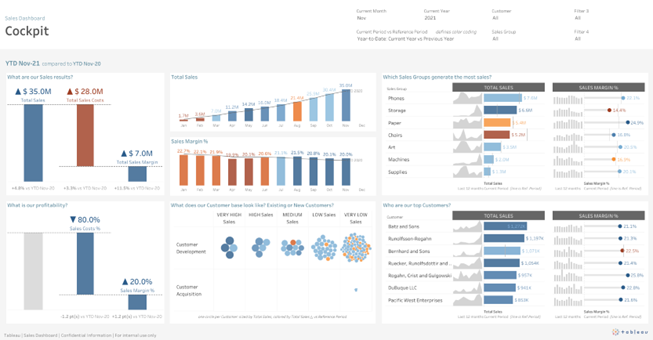
Above: A look at the Sales Expert accelerator, cockpit dashboard.
How Do Tableau Accelerators Work?
You decide you are interested in accelerators and want to get started. What’s next? The workflow is designed to be pretty linear:

-
Tableau Exchange
The Tableau Exchange is where you will find available pre-built solutions created by Tableau and its partners. Those solutions are dashboard extensions, connectors and accelerators. Select the Accelerators section as shown below.
-
Download Accelerator of Choice
Accelerators are grouped based on industry, department and enterprise application. Based on the subset of data your team is analyzing, make your choice and download the accompanying workbook.
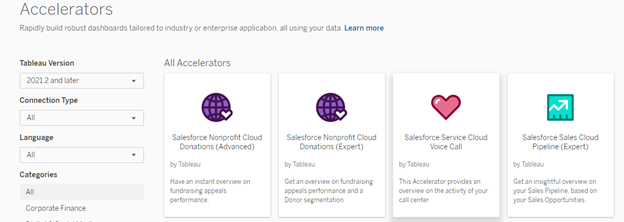
Above: Make choices based on Tableau version compatibility, connection type, language and category.
The exchange has many accelerators to choose from, including the InterWorks Retail Store Performance Accelerator that we shared. I can see what business questions the accelerator answers and what KPIs it will provide (assuming my data can map correctly). When I select the download option, I get a packaged workbook (twbx file).
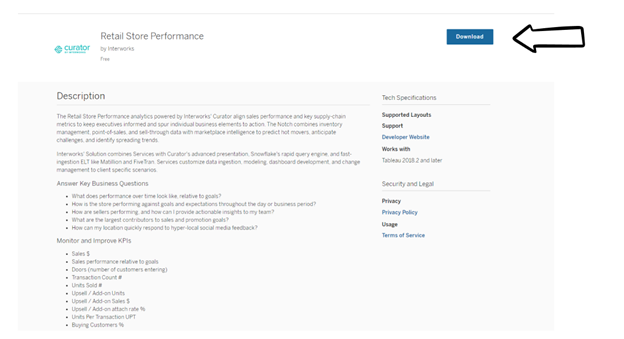
Above: Notice that accelerators give you version compatibility, questions you will get answers to, and KPIs that you will have access to.
-
Map Data to Accelerator
You have chosen your accelerator from the exchange and downloaded the twbx file, but the resulting visuals display generic sample data, not data from your organization. To connect your data to an accelerator, you must map your data to the fields (or required attributes) the accelerator has built in.
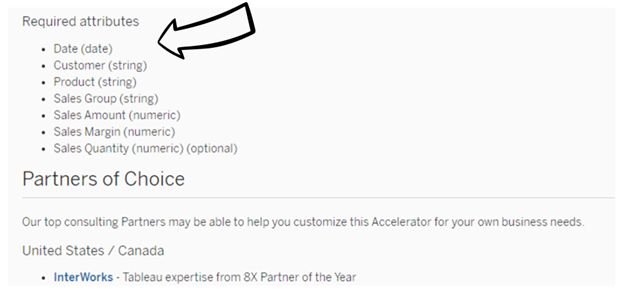
Above: The required attributes section points out the necessary dimensions and measures needed to map data correctly.
If you are using an enterprise application accelerator (Marketto, LinkedIn, SalesForce, ServiceNow, Oracle Eloqua), your own data will populate by simply navigating to the Data Source tab and entering your credentials.
For non-enterprise application accelerators (i.e., fitting your own data sources with Tableau), this requires you to connect to the data source, replace the data source and replace references in Tableau Desktop. All to say, this is a heavily manual process. Depending on how aligned your data sources are with the accelerator, it can be a quick process or one that requires some intense data preparation. The reality of the workflow includes a decent likelihood of breaking fields.
To address this, Tableau demoed a new data mapping feature that will make the process a bit smoother. It is said to be released later this year.
If you are fortunate enough to correctly map your data to the accelerator, the heavy lifting is done. Your only job now is to consume the insights built into the dashboard and customize the workbook in any way you see fit.
Do I Want Accelerators?
Now that we understand the basics of accelerators, let us make sure we understand what they are not. This is worth making crystal clear: accelerators ARE NOT a substitute for human beings creating and designing content in an organization. Accelerators allow users to consume pre-constructed insights. They are not meant to diminish the value of professionally built content.
While accelerators theoretically provide instant insights many users want, there are some considerations to ponder before trying to connect one to your own data source. As mentioned before, the data mapping component, as it exists today, varies in levels of complexity. Depending on your data source and structure, the mapping process might take a few hours, or a few resources. For example, a common data source like Marketo where fields are the same across the board would map much quicker than a production data source of many tables living in a cloud data platform.
For organizations using Salesforce, there are many accelerators on the Tableau Exchange that can plug directly into your Salesforce environment. These are available NOW in Tableau Cloud and require the least amount of effort to deploy today. Salesforce Admin Insights was recommended as one worth checking out.
To put a bow on this, I have laid out some scenarios where accelerators make sense and where they do not.
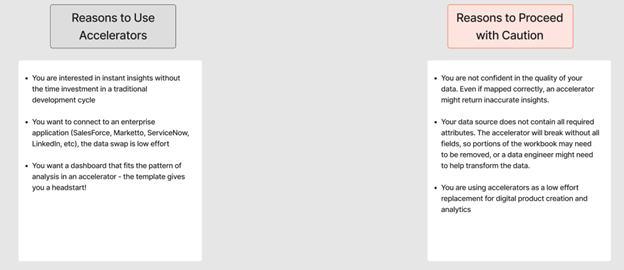
As mentioned, accelerators are currently available on the Tableau Exchange, with a select few available in Tableau Cloud. They are also available in Tableau Desktop version 2022.2 and higher.
Closing Thoughts on Tableau Accelerators for Now
While we are still in the early phases of accelerators, I am intrigued about this particular use case Tableau is attempting to address (lower effort on the dev side, seeking instant insights). Again, I want to emphasize that these are not replacements for developers or professionally designed digital products. There is certainly promise here, but as I pointed out, there’s room for improvement, specifically when it comes to mapping data.
For anyone who is interested in talking more about the potential of accelerators, feel free to hit up the team! Also stay tuned for an upcoming blog post that details all the Tableau Accelerators created by InterWorks to date.


